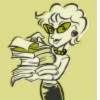 Ellis, Deborah. 2002. PARVANA’S JOURNEY. Toronto, Ontario: Groundwood Books. ISBN 0888995148
Ellis, Deborah. 2002. PARVANA’S JOURNEY. Toronto, Ontario: Groundwood Books. ISBN 0888995148PLOT SUMMARY
After burying her father, 13-year old Parvana continues her journey in search of her mother and siblings. In war-torn Afghanistan it isn’t safe to walk around—much less if you are a girl. Parvana wears her hair short and passes as a boy so she can continue her search in the relative safety reserved only for males in this country. Along the way, Parvana is joined by new ‘family members:’ a baby brother, an older brother and a sister. Together, they wander Afghanistan in search of food, water, shelter from bombs and their families. PARVANA’S JOURNEY reveals the wretched situation of the people of Afghanistan during the 1990s and the relentless hope held by its children whom “we force to be braver than they should have to be” (Ellis, 5).
CRITICAL ANALYSIS
PARAVANA’S JOURNEY takes the reader on a trip across Afghanistan with a 13-year old girl. Afghanistan and the Muslim culture, specifically under Taliban domination, is depicted through a variety of literary methods. Ellis uses language, characterization and setting to portray the society and culture of Parvana’s world.
Ellis’ use of language adds flavor to the text through both description and dialog. The characters’ names such as Parvana, Shauzia and Asif allude to a middle-eastern setting. The story is peppered with non-English terms like burqa, toshak and shalwar kameez. While these terms are not defined in the text of the story, context is often all the reader needs to understand the general meaning of unfamiliar words. For some culture-specific terms, Ellis provides a definition in a glossary at the end of the book.
Dialog, both internal and external, is another cultural indicator in PARAVANA’S JOURNEY. The main character, Parvana, acknowledges to herself she has “given up trying to understand why the Taliban hated women” (p.12). The children speak to each other of things such as tanks, bombing planes and empty bellies. They build shelter with plastic sheeting and pick up grains of rice to be eaten raw when there is no other food. While this type of danger and poverty can and does occur in many places around the world, it offers a view of the grim situation in which many Afghan children find themselves.
The characters in Ellis’ novel offer further insight into Afghan society. Parvana and her family are of a progressive, less traditional ilk. Parvana’s father taught her poetry, astronomy, math and English. Her mother is an organizer, helping families work together and teaching children in the camps. She also writes articles for women’s magazines which are forbidden in Afghanistan. Asif, Parvana’s new ‘brother,’ seems to have traditional male attitudes toward females. He frequently berates Parvana calling her stupid and weak. However, he is atypically patient and tender with baby Hassan. Though there are many opportunities for Asif to leave, he chooses to stay with Parvana and Hassan, as he puts it, “Just to annoy [her]” (p.193). This caveat is Asif’s attempt to save face. It shows his internal struggle between the traditional view of female inferiority and the need for family and community.
The setting, too, reveals the cultural background of PARVANA’S JOURNEY. There are descriptions of green valleys, hills and deserts. There are also descriptions of land mine fields, villages reduced to rubble and camps for Internally Displaced Persons. Thus, a picture is painted of a once beautiful country now decimated by the ravages of war.
Ellis’ young adult novel, PARVANA’S JOURNEY, offers a perspective on the lives of children in war torn Afghanistan. With no one to take care of them, Parvana, Asif and Hassan must care for themselves. Thus, readers watch the children attempt to rebuild their lives and become a family under the most adverse of circumstances.
REVIEW EXCERPTS
“In this highly readable sequel to The Breadwinner, it's wartime in Afghanistan, and thirteen-year-old Parvana must disguise herself as a boy as protection against the Taliban. After she sets off to find her mother and siblings, she forms a makeshift family with a baby and a contrary boy with one leg. Ellis deftly integrates engrossing characterizations with the harsh daily realities of war.” (Horn Book)
“A bittersweet ending offers some hope for Parvana and her family, but readers are left with a horrifyingly realistic picture of the effect of war on children. While the reading is not difficult, the grim content cries out for discussion. An unforgettable read.” (School Library Journal)
Reviews obtained from Follett Library Resources and accessed at:
http://www.flr.follett.com/search?SID=c211074453f514ff63ced2a0fe154f24
CONNECTIONS
Other books in this trilogy by Deborah Ellis:
Ellis, Deborah. The BREADWINNER. ISBN 978-0-88899-419-6
Ellis, Deborah. MUD CITY. ISBN 978-0-88899-518-6
Other novels about refugees:
Williams, Mary. BROTHERS IN HOPE: THE STORY OF THE LOST BOYS OF SUDAN. ISBN 978-1-58430-232-2
Lombard, Jenny. DRITA, MY HOMEGIRL. ISBN 978-0-399-24380-6


